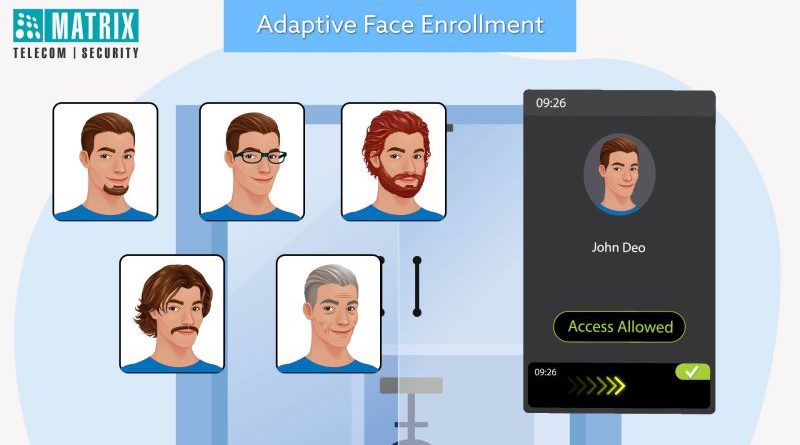Evolution of Facial Recognition: Adaptive Face Enrollment for Accuracy and Convenience
Facial recognition technology represents a remarkable stride in biometric innovation, offering a secure and smooth method for verifying individuals based on their distinct facial features. Utilizing artificial intelligence and deep learning algorithms, these solutions meticulously analyze unique facial attributes like structure, contours, and proportions to create personalized templates for each individual.
How does Adaptive Face Enrollment Change Face Recognition Technology?
Imagine a bustling corporate office scenario:
Let’s introduce John Doe, a seasoned employee with four years of experience in the organization. One day, he enters the office wearing a pair of glasses. In conventional facial recognition systems, such alterations could potentially result in false rejections or unauthorized access. In the past, this change in John’s facial appearance due to an accessory might have triggered an identification error in the facial recognition system.
However, in today’s world of cutting-edge face recognition solutions, the system swiftly detects this change and automatically captures an updated image of John’s face. Thanks to its adaptive understanding of users’ evolving facial features, the process remains seamless and precise. This new image effortlessly integrates into John’s profile without requiring any manual intervention. As John continues to navigate the office, the facial recognition system adeptly adapts to these changes, ensuring uninterrupted access. Over time, individuals’ appearances naturally change due to factors such as aging, hairstyle modifications, or the addition of accessories like glasses.
Adaptive Face Enrollment: Revolutionizing Facial Recognition Solutions
Adaptive Face Recognition and Enrollment stands as a revolutionary feature within Matrix Face Recognition Solutions, elevating the accuracy and efficiency of facial recognition systems by dynamically adapting to changes in individuals’ facial appearances over time. This innovative feature effectively addresses challenges posed by various factors, including the aging process, alterations in lighting conditions, diverse facial expressions, and the utilization of accessories such as glasses or scarves that may partially obscure the face. Traditional facial recognition systems often struggle to accurately identify users when their facial features undergo such changes, resulting in higher rates of both false acceptance and false rejection.
Matrix’s Adaptive Face Recognition and Enrollment harnesses the power of advanced artificial intelligence and deep learning algorithms to continually monitor and update users’ facial templates as changes manifest. Upon detecting a change, the system seamlessly captures an updated image of the user’s face and integrates it into their existing profile, eliminating the need for manual re-enrollment. This ensures that the facial recognition system maintains optimal accuracy and reliability over time, irrespective of variations in users’ appearances.
Benefits for Organizations Include:
- Elimination of Re-Enrollment Hassles: In stark contrast to conventional facial recognition systems that may necessitate periodic manual re-enrollment of facial templates, Matrix’s adaptive approach abolishes the need for such interventions. This not only saves time but also reduces effort for both users and administrators.
- Real-Time Updates: The system detects changes in real time, allowing for instant updates to users’ facial templates. This ensures that the recognition system consistently aligns with users’ current appearances, thereby enhancing accuracy and minimizing false rejection rates.
- Handling Variability: Users’ appearances can naturally vary due to factors like age, lighting conditions, and facial expressions. Matrix’s adaptive approach adeptly manages these variations, guaranteeing consistent and reliable recognition even when users deviate from their original enrollment images.
- Enhanced User Experience: Users can rest assured that their facial templates remain up-to-date. This translates to a seamless and convenient experience, bolstering user satisfaction and reducing frustration.
- Reduced False Acceptance and Rejection Rates: By proactively updating facial templates to accommodate changes, the system drastically reduces the likelihood of false rejections, which can occur when legitimate users are denied access, and false acceptances, where unauthorized individuals gain access.
Additional Advantages Include:
- Heightened Accuracy: This feature significantly amplifies the accuracy of the facial recognition system by adapting to alterations in users’ appearances, ensuring more reliable and precise identification.
- User Convenience: Users no longer face the inconvenience of re-enrolling their facial templates when their appearance evolves. The system efficiently manages updates, guaranteeing a smooth and user-friendly experience.
- Enhanced Efficiency: The automated and real-time nature of this feature obviates the need for administrators to manually oversee re-enrollments, thus reducing the administrative burden associated with maintaining accurate templates.
- Time-Saving: The absence of manual re-enrollment processes translates into time savings for both users and administrators, contributing to increased productivity across the organization.
- Elevated Security: With continuously updated facial templates, the system is better equipped to detect and thwart unauthorized access attempts, thereby fortifying the overall security posture.
In summary, Adaptive Face Recognition and Enrollment stands as a robust feature that underscores Matrix Face Recognition Solutions’ unwavering commitment to accuracy, convenience, and security. By dynamically adapting to changes in users’ appearances, the system ensures a high level of accuracy and user satisfaction.
Learn more about Matrix Face Recognition Solution!
Additionally, explore our Smart Facial Recognition Door Controller – COSEC ARGO FACE, equipped with deep learning algorithms and adaptive understanding.

